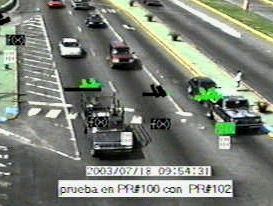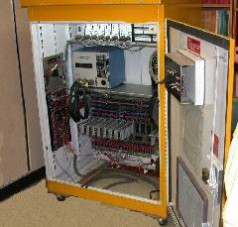The Traffic Engineering Laboratory was constructed in 1988 to support instructional material taught in the course INCI 4137 – Introduction to Transportation Engineering, as well as for the advanced undergraduate elective course INCI 5146 – Introduction to Traffic Engineering. Currently this lab also supports the data collection and analysis activities for the CAPSTONE Integrated Design Course (INCI 4950) in most of the aspects related to traffic studies. Also, this lab supports the initiation of research activities for the course INCI 4998 – Undergraduate Research. An area of 400 square feet has been enclosed for this laboratory.
The laboratory is equipped with an intersection cabinet containing a NEMA controller hardware setup that allows students to become familiar with the typical operation of an intersection controller and the control design and programming commands. An Auto scope machine vision processor is also available for vehicle detection, traffic count, classification and speed measurements, and incident detection tasks.
The laboratory provides a setup of three desktop computers. Traffic analysis and simulation programs such as SIDRA, SYNCHRO and SIMTRAFFIC, SATURN, TRANSIT 7F, and PASSER were acquired to analyze and simulate isolated intersections as well as progressive systems. The NLOGIT program was acquired to perform statistical analysis of transportation data.
Equipment for fieldwork activities has been acquired for the execution of traffic and transportation studies in intersections or road segments. PEEK and NU-METRICS traffic classifiers are available for traffic counts, vehicle classification, and speed-related measurements; laser guns are available for vehicle speed and distance-related measurements, measuring wheels are available for distance-related measurements, and video cameras, television, videocassette, stopwatches, and clipboards are available to measure time-related characteristics and other data-related tasks.
To support the undergraduate research course, the laboratory includes a Driving Simulator composed of three main features. The first component is the driving cockpit, which includes of a driver chair, steering wheel, acceleration/brake pedals, gear shift and turning signals. The second element features the visual display provided by three fixed projectors and a set of screens that provides a panoramic view of the virtual scenario with 120 degrees of visibility. The last component is the computer hardware of a laptop and desktop computer with an NVidia GTX 980 graphic card, surrounding audio system and the simulation software of Realtime Technologies Inc. (RTI).


